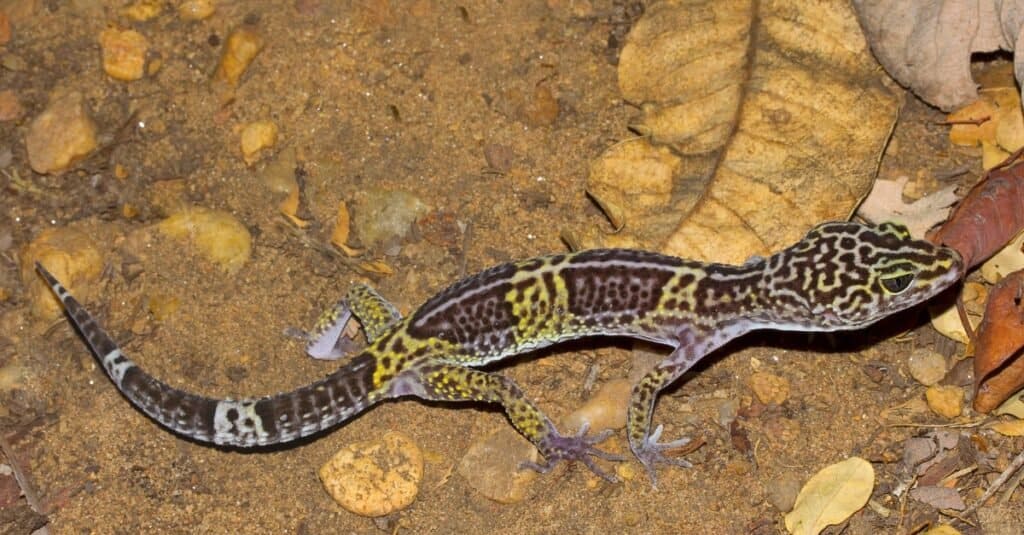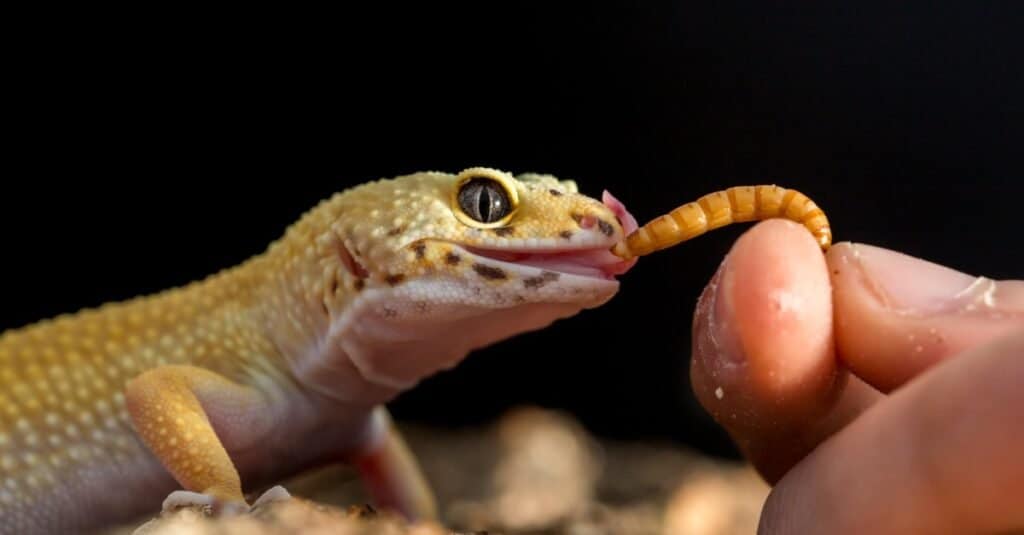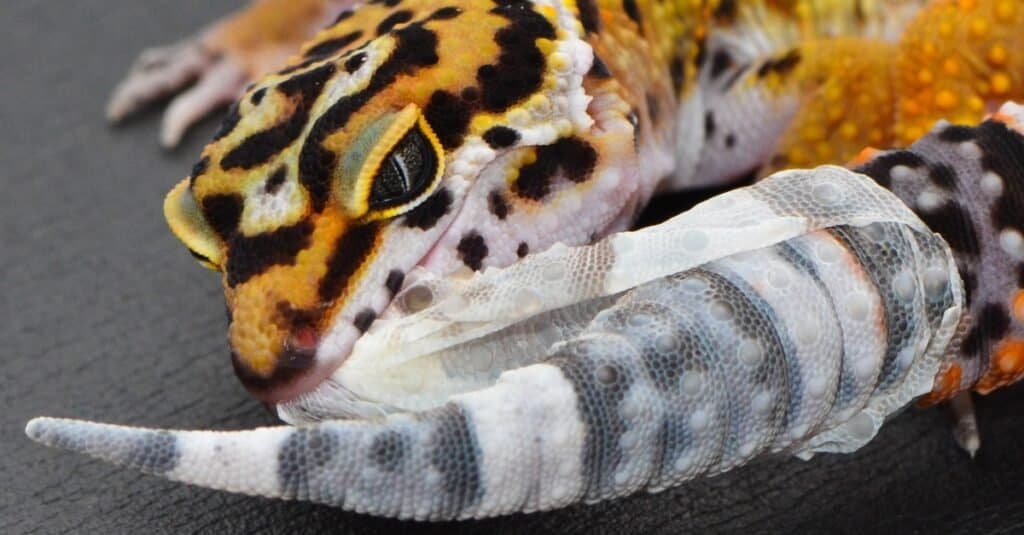Eternally smiling and heart-meltingly adorable, leopard geckos have quickly overtaken even the bearded dragon in terms of popularity as pets. Nowadays, the leopard gecko, known formally as Eublepharis macularius, is held up as the best low-maintenance pet for both beginner reptile enthusiasts and expert herpetologists alike. One of the first questions people interested in this handsome spotted lizard ask is: what do leopard geckos eat?
Whether you want to own a leopard gecko yourself or you’re just curious about what these feisty yet friendly little lizards eat in the wild, we’ve got you covered. Let’s take a detailed look at the average leo’s diet both in captivity and in their native habitats.
What Do Wild Leopard Geckos Eat?

Of course, leopard geckos didn’t just spring up in homes all over the world overnight. They are native to very dry, harsh deserts and mountainous grasslands in the Middle East. More specifically, they occupy the countries of Iran, Afghanistan, India, Nepal, and Pakistan. So, what could a little gecko possibly find to eat in such an unforgiving region?
Well, it turns out that these rough conditions are perfect for wild leopard geckos looking for a feast! Because they are highly opportunistic predators, they will eat just about anything that crosses their path–as long as it’s an insect or some other small invertebrate. Leos are primarily insectivorous, so they will generally only eat small-to-medium-sized insects and other invertebrates. In rare cases, they will eat small rodents, other lizards, spiders, or scorpions, but only if they are desperate and/or are starving.
Additionally, these small yet mighty crepuscular geckos will only pursue live, moving prey. This means they won’t eat anything that’s already dead or won’t put up a fight. Despite these rather picky preferences, though, they still manage to find a diverse array of juicy bugs to munch on in the wild, including:
- Crickets
- Locusts
- Centipedes
- Beetles
- Grasshoppers
- Mealworms
- Springtails
- Flies and fly larvae
- Roaches
- Snails
- Scorpions (rarely)
- Smaller lizards (rarely)
- Spiders (rarely)
- Mice and other very small rodents (rarely)
How Do Wild Leopard Geckos Hunt Their Prey?

A young wild leopard gecko on the prowl for its next meal
©iStock.com/ePhotocorp
Like we touched on earlier, leopard geckos are extremely opportunistic predators. They will pounce on just about any insect or invertebrate that wanders too close. In general, they are either crepuscular or nocturnal hunters. Crepuscular geckos are mostly active around the hours of dawn and dusk, while nocturnal geckos are mostly active at night once the sun has set.
Fortunately, leopard geckos have great vision, especially night vision. This adaptation helps them greatly in sneaking up on their prey during such odd hours. Additionally, they are ambush predators, so the way they hunt is straightforward and uncomplicated.
A leopard gecko looking for a meal will usually hide behind or around rocks or bushes, waiting for an insect or other invertebrate to cross their path before quickly leaping at their prey. They use their uniquely sticky tongues to snatch up their unfortunate meals in the blink of an eye!
What Do Pet Leopard Geckos Eat?

A pet leopard gecko takes a bite out of a mealworm
©iStock.com/MattiaATH
In the mid-1970s, reptile breeders began capturing and transporting leopard geckos away from their native habitats in order to breed and sell them. They quickly became popular pets amongst reptile experts and novices due to their simple care requirements and unusually friendly, outgoing personalities.
The ideal diet of a pet leopard gecko is very similar to its cousins’ diets in the wild. Being strict insectivores, they eat a wide range of feeder insects that are bred and raised in careful conditions to prevent the spread of parasites and illnesses. This is one of the reasons why captive geckos tend to live longer than those in the wild, as their food is far less risky for them to eat.
There are many nutritious and delicious (to your gecko, anyway!) feeder insects on the market to choose from, such as:
- Mealworms
- Superworms
- Dubia roaches
- Crickets
- Waxworms
- Hornworms
- Butterworms
- Phoenix worms (also known as black soldier fly larvae or NutriGrubs)
How to Feed a Pet Leopard Gecko

Don’t be fooled by the leopard gecko’s goofy smile; they are surprisingly fierce hunters!
©iStock.com/CathyKeifer
Feeding a pet leopard gecko is both simple and incredibly entertaining to observe firsthand. They hunt in mostly the same way as their wild counterparts: they ambush their prey after stalking it from a distance or simply waiting for the insect to get too close.
When feeding a leopard gecko, it’s best to offer them as many insects as they will eat within a 5 to 10-minute period. Additionally, to prevent choking or impaction, always opt for insects that are smaller than the width of the space between the gecko’s eyes. Variety is key, as your gecko will quickly tire of eating the same thing each day.
Most reptile owners simply drop the feeder insects into their gecko’s enclosure or food dish one by one, allowing the gecko to snatch them up at their leisure. There are also feeding tongs available on the market if your gecko is especially picky (or, alternatively, aging/disabled) and needs a bit more help. Hand-feeding is also an option, but this discourages your gecko’s natural hunting behaviors and can make them lazy over time.
Do Leopard Geckos Need Vitamin Supplements?

Calcium supplements help facilitate proper shedding as well as bone and muscle health. Geckos commonly eat their shed skin to reabsorb its nutrients
©iStock.com/P A Collins
It is crucial for a captive leopard gecko’s diet to have a calcium and vitamin D3 supplement added to all of their meals. There are a few key health reasons for this.
First, while wild geckos get enough calcium and D3 from their diets naturally, pet geckos need a supplement. This is because most commercially-sold feeder insects are very high in phosphorus and comparatively low in calcium. In addition, vitamin D3 is necessary for the gecko’s body to properly absorb and utilize calcium.
Without enough calcium and D3 in their diet, a leopard gecko in captivity will quickly become prone to malnutrition and metabolic bone disease, a painful and often fatal illness that deforms their bones significantly. While it is partially reversible to an extent, MBD is incurable and very stressful for the afflicted reptile.
Ideally, a captive leopard gecko’s calcium supplement should have a calcium-to-phosphorus ratio of at least 2:1, with 3:1 or higher being even better. Most supplements are either provided in powdered or liquid formulations and are designed to either be added directly to the insect via “dusting” or fed directly to the gecko via a syringe or eyedropper.
Can Leopard Geckos Eat Fruits and Vegetables?

A healthy-looking leopard gecko strikes a proud pose; thanks to selective breeding, many unique colors and patterns are now available
©iStock.com/Nynke van Holten
Neither wild nor captive geckos should eat anything other than insects and small invertebrates. Fruits and vegetables should be avoided at all costs. The main reason for this is that their bodies are unable to digest plant matter properly. If eaten, the undigested fruits or vegetables can cause impaction, a painful blockage of the digestive tract.
In addition to this, most leopard geckos simply aren’t interested in eating non-moving prey. You can hold a banana or a piece of lettuce in front of a gecko for as long as you’d like, but they will almost definitely turn their nose up at it and walk away.
Finally, plant matter doesn’t offer much in the way of nutrition that leopard geckos need to thrive. Most fruits and vegetables are fairly high in oxalates, or oxalic acid, which interferes with the gecko’s body’s absorption of calcium.
The photo featured at the top of this post is © iStock.com/MattiaATH
Thank you for reading! Have some feedback for us? Contact the AZ Animals editorial team.






